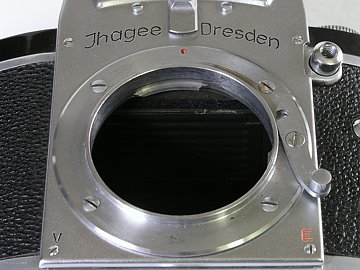
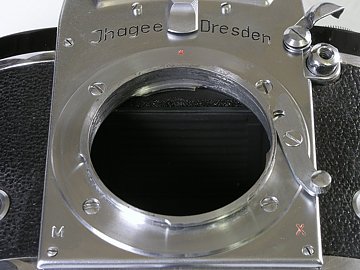
Single Exakta lens bayonet; internal flange visible inside the lens throat; the outer lip is smooth.
Double bayonet; external flange (on the outer lip) is visible in addition to internal one.
|
Exakta System Lenses |
|
This is a huge subject, and I doubt any collector can address it in width and depth it deserves. Therefore this article should be understood as a mere introduction, just an attempt to scratch the surface. Well, better this than nothing. Keep in mind, that this article refers to the "real" 35-mm Exaktas made by Ihagee Dresden, starting with the Kine Exakta of 1936, and ending with the VX 500 of 1969. Some later models (and some other brands of cameras) used bayonets compatible, partially compatible, or incompatible with the classic Exakta mount; these will not be discussed here. I am aware that many readers of this article may know more on the subject than I do, or, at least, may supply additional information I do not have. Any comments, corrections, and bare facts will be most appreciated. Note: All pictures shown here will, when clicked upon, bring up large (XGA) versions for better detail scrutiny. The Exakta lens bayonet This bayonet was usually made of steel (although I've seen ones made of aluminum in some early post-WWII models). It uses a simple lens-locking mechanism: align the red dots, push, and turn the lens clockwise. An external, spring-loaded catch grabs a small pin in the base of the lens, and its lever has to be pressed in order to reverse the operation. The lens is secured with bayonet protrusions inside the mount ring, sunk into camera body (see the double-bayonet note below). The mechanism is simple and quite secure, although not immune to mechanical wear; on some bodies lenses have some play. Most of that, however, is along the lens-mounting plane and does not affect the lens-to-film distance or the quality of pictures taken. The Exakta mount did not provide any coupling for the lens aperture or otherwise (see below about external coupling on lenses), therefore any lens could be used with any body made from late Thirties to the Seventies. This is also true about Exa bodies, except that the original Exa and Exa I had some vignetting along longer sides of the frame when used with lenses longer than 100 mm (or lens extensions providing image magnifications greater than 0.7x). There is another significant (and rarely mentioned in the literature) exception. Longer lenses with large apertures (180mm f/3.5 and larger) required wider lens throat than that provided by the standard mount which would cut off some light in the corners. To accommodate these lenses, in 1953 Ihagee engineers introduced an upward-compatible version of the mount. It had two locking bayonet flanges: one internal (within the mount ring), compatible with "regular" lenses, and one external, protruding outside of the camera body. The latter is just ignored by "regular" lenses, while the "big" ones have a mechanical connection only for the external ring, with no mechanical parts entering the mount throat at all. There were also a few lenses with both external and internal mount. |

|

|
| Single Exakta lens bayonet; internal flange visible inside the lens throat; the outer lip is smooth.
| Double bayonet; external flange (on the outer lip) is visible in addition to internal one. |
|
The whole mount is secured to the body with four easily accessible screws, and can be exchanged in a minute or so. Therefore adapting your camera to accept external-bayonet lenses was a quick operation, as long as you had the double mount available.
Some Exakta and Exa bodies available now on the market have mounts changed by previous owners, either to replace worn ones, or to provide compatibility with external-bayonet lenses. Usually the differences are hard to notice, except for changes in the shape of the lens-locking lever. Some models (maybe only the second version of Exakta II?) had original mounts painted black, and the replacement is then easy to spot. I believe the camera does not become "less original" with this alteration: Exaktas were working-photographer's tools and they were supposed to undergo user's modifications serving this purpose. Lens adapters Some lenses made for other cameras, with different mount systems, can be still used with Exaktas or Exas with help of lens adapters. These, theoretically, can be of two types: mounted into the camera's bayonet (i.e., going between that bayonet and the lens), or replacing the entire lens flange, which is held in place with four easily accessible screws. As a matter of fact, the manufacturer used the second approach in Exa 1B, which was made with the flange designed to accept the M42 (Practica/Pentax) screw-mount lenses. Because most lenses (Leica, rangefinder Contax) require a shorter lens-to-film distance than Exakta's, and/or a wider mount throat (Pentax K, Minolta MD, Nikon SLRs), the only adapter I have seen is the replacement type for the M42, screw mount. These are possible because the M42 lens spacing is 45.46 mm, more than Exakta's 44.70 mm. There were also adapters allowing Exaktas to use the 39 mm, Leica thread lenses. Because Leica has a smaller film-to-flange distance, a lens mounted with such an adapter will not focus to infinity, still being useful for close-up work. A separate group of lenses which work with the Exakta are those using an interchangeable mount; most often the T-mount or Adaptall type. Some custom-made adapters for other lenses can also be found; usually they are only suitable in the close distance range. In the opposite direction, there were numerous adapters allowing for use of Exakta lenses on other cameras. Manual, preset, and automatic lenses In SLR cameras the image viewing is done through the lens, and this is best done with the lens wide open, i.e., with the largest aperture possible (lowest aperture number). To actually take the picture the aperture has to be closed down to the opening actually needed to provide the proper exposure. Manual aperture lenses. Initially, this was entirely left to the photographer: after using the finder to evaluate the picture and to set the distance (sharpness), you had to take your eye off the finder, turn the aperture ring to the proper value, then look into the viewfinder again and release the shutter. This was a slow and cumbersome procedure, and it was possibly the main disadvantage of SLRs as compared to rangefinder cameras. These lenses can be divided into two groups: without and with clickstops at discrete aperture values. The latter are somewhat easier to use, as the aperture can be, with some practice, closed down without taking your eye off the viewfinder. Catalogs in German refer to the first type as Normalblende (NB), and to the second one (with click stops) — as Rastblende (RB). Preset aperture lenses. German makers introduced this improvement in the early Fifties, naming it Vorwaltblende (VB). After evaluating the exposure, the needed aperture was preset by means of a lift-and-turn (or press-and-turn) ring, and, while viewing the image at full aperture, immediately before releasing the shutter the photographer had to turn the ring all the way to the preset value — it wouldn't go any further. This could be done quite easily without taking your eye from the viewfinder, a major convenience. Semi-auto aperture lenses. In this kind, the lens had an external "plunger" release lever. When pressed, this lever would close the aperture to the set value, and then activate the shutter release on the camera body. This was a smart solution, as such lenses would work just fine with existing camera bodies. The reason they were referred to as "semi-automatic" was that the aperture-closing mechanism had to be cocked up each time with a special lever, usually at the bottom of the lens barrel. The German term is Spannspringblende (ASB). Automatic aperture lenses. An improvement to the previous type: an internal spring device would re-open the aperture to the full value when the external release was no longer pressed, so that the mechanism no longer needed to be re-cocked. This is, from the photographer's viewpoint, as convenient as any solution using internal coupling mechanism (a special pin, ring, or electronic connection in modern cameras), and it has the obvious advantage of retaining compatibility with camera bodies of any vintage. The automatic lenses are sometimes divided into two groups:
Of these, the former are slightly more convenient (the aperture closes instantaneously, not waiting until the release is further pressed), but they are also less reliable and you may find many lenses where the mechanism is broken. Quite often a broken jumping aperture mechanism keeps functioning as a progressive one. This is, I think, why VSB lenses have been replaced with VDB ones. Actually, some users and collectors refer to both semi-auto and auto aperture lenses as "automatic". Major Exakta lens makers Lenses for Exakta were made by many manufactures. Most prominent it this group were the German makers, traditionally associated with Exakta in users' and collectors' minds. Out of these, no doubt, Carl Zeiss Optical Works of Jena was synonymous with high-quality, German lenses. After the war Jena was in the Soviet-occupied Eastern zone of Germany (later the "German Democratic Republic" or DDR) and the company, now a state property, initially kept using its pre-war name. The trademark owners, however, were lucky enough to make it to West Germany, and after some time they won the legal battle for the Zeiss name, so the East German Zeiss lenses were often marked simply as aus Jena. Here are the major German companies manufacturing lenses for Exakta, with the most popular model names.
Interestingly, Ludwig really made just one lens type: the 2.9/50 Meritar (their Victar is rather rare), but what the maker missed in variety, they made up in numbers: the so-so Meritar was often supplied as the less-expensive standard lens with the Exas. The factory seemed to enjoy a special relationship with Ihagee, being located at the outskirts of Dresden. Other German companies also made Exakta lenses, although in smaller numbers. Most notable of these are:
Many East-German lenses from the mid-Sixties on are marked as the Pentacon brand. Variety is repulsive to the Communist mind: this was the time when East Germany "united" all individual optical companies, already state-owned, under the Pentacon People's Combinate name and rebranded most of their products. From non-German companies, Angenieux of Paris is perhaps the best-known supplier. This French company was well-established as one of the leading maker of high-quality lenses for professional movie cameras, and their Exakta lenses, quite expensive, were recognized as one of the very best available. Among collectors, they still seem to be much sought-after. The availability of various makers' lenses on today's collector market still reflects the Iron Curtain division of Europe. While the East-German lenses (Zeiss of Jena, Meyer of Görlitz, Ludwig of Weixdorf) were sold both in the West and in the Communist camp, those from West Germany (all others listed above) were available only in the West. They were also usually more expensive than their Eastern counterparts because of higher labor cost in West Germany and the very loose cost-to-price ratio built into the Communist export policies. This means that usually the Western lenses are not only more difficult to find, but also they may fetch relatively higher prices. |
Top row:
Middle row:
Bottom row:
|
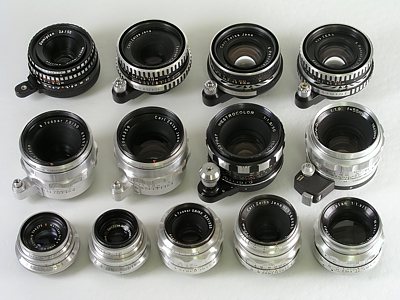
| ||||||||||||||||||||||||
|
Other standard lenses
There was one lens branded by Ihagee as their own: the manual 3.5/54 Exaktar, a quite mediocre triplet, sold until the early Fifties bundled with some Exakta cameras. This was really a re-branded Meyer Primotar lens.
The very common, manual 2.9/50 Meritar by E. Ludwig replaced the Exaktar as the bottom-level entry, and it was sold, mostly with Exa cameras, until the mid-Sixties. The 2.9/50 manual Trioplan by Meyer was the cheap lens of that time, being made for at least a dozen of other East-German cameras. It was of a simple triplet design, and retailed for about half the price of the 2.8/50 Tessar. On the other end of the spectrum, the 1.9/55 Meyer Primoplan was a nice lens, manufactured from 1938 or so to 1954, with manual or preset aperture. Another Meyer lens, the 2.8/50 Domiplan, a Cooke triplet design, was quite popular in preset and automatic aperture versions for many East-German cameras. Schneider's 1.9/50 Xenon (from the mid-Fifties, preset or auto) was considered one of the better-made Exakta lenses; it also had a version with a selenium light meter on the top. A quite similar lens, 1.9/50 Westrocolor was made by Isco-Göttingen. Another quality, standard lens for Exakta was the 1.9/55 Auto-Quinon by Steinheil. Lenses by this maker were always beautifully finished, and their auto versions shared an unorthodox shutter release. Wide-angle lenses Wide-angle lenses for SLR cameras are more difficult to design and make than those for rangefinder models. This is because of the need to provide room for the mirror between the lens and the film frame. Lens makers accommodate this need with the inverted telephoto design, where the lens entrance pupil is located well beyond the rear lens element. The first inverted telephoto lens for Exakta was the famous 2.5/35 Angenieux Type R1; the makers term "retrofocus" is now also widely used to denote this type of construction. Wide-angle lenses for Exakta are almost synonymous with one name: Flektogon from Carl Zeiss, Jena. The best-known is 2.8/35 Flektogon, practically a standard among wide-angle lenses. There were also two other lenses available under the Flektogon name: 4.0/25 and 4.0/20. The latter is the widest-angle lens made by Zeiss for Exakta and seems to be in high demand among both users and collectors. Meyer-Optik from Görlitz on the Polish border also had some wide-angle offerings for Exakta. The 4.5/35 mm Primagon was a less expensive alternative to the 35 mm Flektogon (although its smaller maximum aperture makes it less desirable), and the 3.5/30 mm Lydith is an excellent general-use, wide-angle lens, less expensive than the Flektogons, but valued for its image quality. I've seen both only in the preset aperture version. Schneider had two high-quality, wide-angle lenses on the market: the 4.0/28 and 2.8/35 Curtagon models of the late 1950's, but their most unique offering in this area was the 4.0/35 P.A. Curtagon perspective-control (shift) lens. This was, as far as I know, the only such lens for the Exakta.
| Here is a sample of wide-angle offerings by Zeiss and Meyer. Top row:
Bottom row:
| 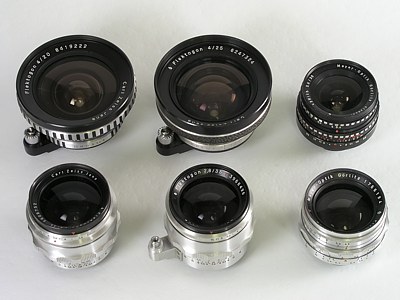
|
The Zeiss lenses existed in various finishes, and there was also a close-focusing 2.8/35 Flektogon, going down to 18cm (as opposed to 30cm in the regular version).
Long focal length lenses I am not using the term "telephoto" here, as many of these lenses, were not, strictly speaking, of the telephoto design. This term actually denotes lenses with the entrance pupil moved forward, even ahead of the front element, in order to make the lens physically shorter. Long lenses, telephoto or not, are easier to design and make than wide-angle ones. The main restraint is the unavoidable increase in size and weight for greater focal lengths if we want to keep the maximum aperture at a reasonably large value. If the lens is too dark, using the reflex finder becomes quite difficult, another limitation from which rangefinder cameras are free. Telemegor by Meyer-Optik of Görlitz was one of the most popular names, made in a number of versions from 105 to 400 mm, usually with preset aperture. The 5.5/180 mm Telemegor is a decent and usable lens, quite easy to find on the market now. The same company made the 3.5/180 mm Primotar, a high-quality, big and heavy lens, with an external bayonet and a rotating tripod collar. (Neither of these two is a telephoto design.) Of Zeiss long lenses, two enjoyed (and still enjoy) well-deserved fame: the 2.8/180 and 4.0/300 Sonnar (both preset). Schneider had a number of Tele-Xenar lenses, ranging in focal lengths from 135 to 360 mm (the 135 mm model was also available with a selenium light meter).
Meyer-Optik Görlitz made more than a dozen
long lenses for Exakta, ranging from 100 to 500 mm. Four of them are shown in this picture:
|
| 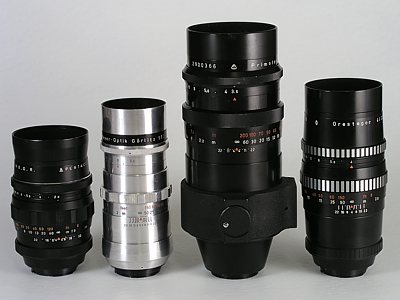
|
Of these, only the Orestor and Orestegor are real telephotos. The Primotar uses the outer bayonet flange and has a rotating tripod ring.
Note that all are supplied with short hoods, greatly improving image contrast; a perk often overlooked with lenses sold today. One great advantage SLRs enjoyed over rangefinder cameras (like Leica) is their usability with really long lenses, above 200 mm. A rangefinder camera will not focus accurately enough for this focal length (very shallow depth of field), and making an auxiliary finder for this viewing angle would be also quite demanding, if at all possible.
Shown here is a 4.5/300 Telemegor by Meyer-Optik Görlitz, introduced in 1952 (#2739517). The lens has a preset aperture and a rotating tripod collar, and it focuses down to 1.8 m.
| It is mounted on an Exakta VX *4.3.u (A&R v3) body of 1955.
| -primotar-300-r.jpg)
|
Meyer also made 400 mm and 500 mm Telemegors, while Zeiss had a 4.0/300 Sonnar and 8.0/500 Fernobjektiv. Zeiss also made two mirror lenses, Spiegelobjectiv 4.0/500 and 5.6/1000 (no aperture blades). Last but not least, there was a Schneider Tele Xenar 5.5/360. Among the more exotic focal lengths there was the 11/2000 Apo-Telastan made by Astro in Berlin with interchangeable mounts, including the Exakta bayonet.
Portrait lenses A special place should be reserved for portrait lenses, with focal lengths of 75-100 mm (most pleasing angle for portrait applications) and wide maximum apertures, minimizing the depth of field. Among these lenses, one stands out: the legendary 1.5/75 Biotar by Zeiss Jena (not to be confused with the standard, 2.0/58 mm Biotar discussed above). Some people say this lens is enough of a reason to use an Exakta even now. It used to be very expensive, and still may be the most desirable lens for that camera.
I bought this pristine 1.5/75 Biotar (#5892835, 1952) in Poland, as a '2002 Christmas present for myself, having paid an outrageous price, with a Varex IIa and three other lenses thrown-in to lessen the pain.
| The previous owner was a retired camera repairman; it was he who made the pretty, matching hood for the lens.
| 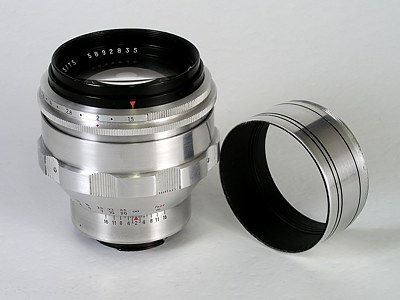
|
Similar portrait lenses were also offered by other makers; for example, the 1.9/75 Primoplan by Zeiss and 2.0/80 Xenon by Schneider, but no other model reached the status of the Biotar among users and collectors.
|
These lenses may use a sunken mount, where optical parts are placed deep to the rear of the lens barrel (in the picture below: to the right), so that actually the optics may be closer to the film plane than the lens mount. This allows the lens to be used on macro bellows while retaining the capability to focus all the way to infinity.
| The best known example of such lens is the desirable Zeiss Tessar 2.8/50, often referred to as the "sunken-mount Tessar". The one shown at the right (#8143737) is from the mid-Sixties. When mounted on the Ihagee bellows unit, its rear glass surface is at the level of the bellows' rear lens mount, like in the case of a "normal" Tessar of this focal length. You may want to see a small article showing the results given by this lens when used on an Olympus E-300 digital camera.
| 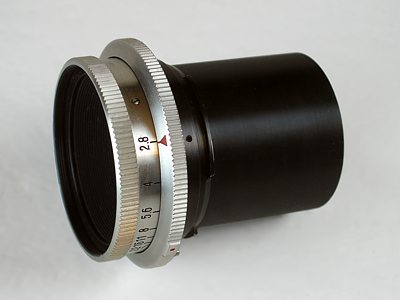
|
A similar lens, sunken-mount 3.5/50 Macro Cassarit was made by Steinheil.
With longer focal lengths the sunken mount was not needed; a short mount was enough to provide enough room for collapsed bellows so that focus can be achieved at infinity. Steinheil had lenses in this group: the 4.5/105 Cassar (also made as Culminar) and 4.5/135 Culminar.
| Web resources
| ||||||||

| Back to my main Exakta page |
| Home: wrotniak.net | Search this site | Change font size |
| Posted 2003/01/07; last updated 2018/01/12 | Copyright © 2003-2018 by J. Andrzej Wrotniak |